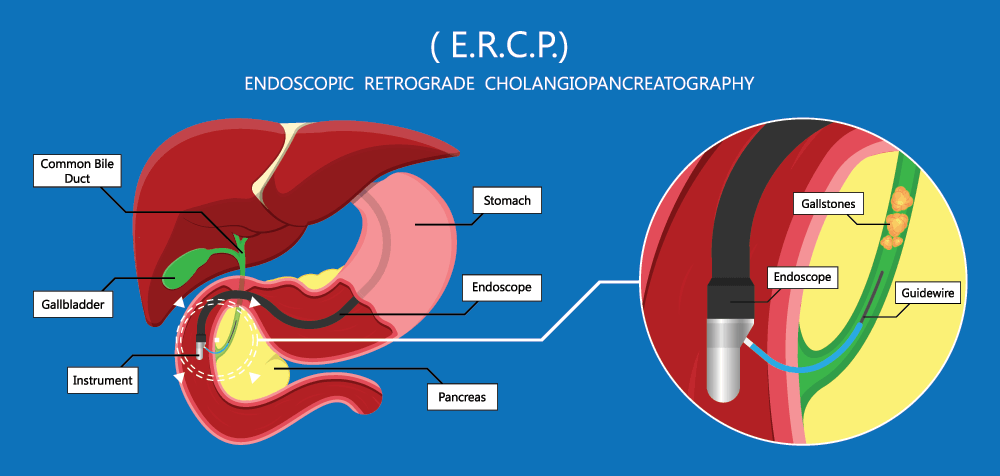procedures
Endoscopic Retrograde Cholangiopancreatography (ERCP)
What you should know about endoscopic retrograde cholangiopancreatography (ercp)
What is an endoscopic retrograde cholangiopancreatography?

Endoscopic retrograde cholangiopancreatography, or ERCP, is an outpatient procedure performed primarily to identify a problem in the bile ducts or pancreas. Disorders from in the bile ducts, gallbladder and pancreas often result from diet, the environment and genetically. They can develop into a variety of symptoms or diseases. ERCP can be used to evaluate gallstones, remove a blockage in the bile duct, and evaluate tumors associated with biliary duct.
If a gallstone is found during the exam, it can often be removed, eliminating the need for major surgery. If a blockage in the bile duct causes yellow jaundice or pain, it can be relieved using ERCP.
Please note that this procedure is only done in the outpatient hospital suites as x-ray imaging is required and present only in the hospital.
Why is an ERCP done?
This procedure helps your doctor evaluate disorders associated with the biliary system. The biliary system is the ducts that drain bile produced by the liver into the small bowel. If there is a gallstone obstructing your bile ducts an ERCP can be done to extract the stone. There may also be tumors within the bile ducts and your doctor can use an ERCP with the assistance of a endoscopic brush to sample cells to get a diagnosis or a device known as a spy-glass to investigate the biliary ductal system.
Your doctor might use ERCP to obtain a biopsy or small tissue sample. A biopsy helps your doctor distinguish between cancerous and non-cancerous tissues. Biopsies are taken for many reasons, and your doctor might order one even if they don’t suspect cancer.
What preparations are required?
It is very important to stop eating and drinking at the times noted in your instructions. Please pay close attention to these instructions to avoid delaying or cancelling your procedure. Tell your doctor in advance about any medications you take since you might need to adjust your usual dose for the examination. Discuss any allergies to medications as well as medical conditions such as heart or lung disease.
What happens during an ERCP?

Your doctor might start by spraying your throat with a local anesthetic or giving you anesthesia to help you relax. You'll then lie on your side or stomach and your doctor will pass the endoscope through your mouth and into your esophagus, stomach and duodenum. The endoscope doesn't interfere with your breathing, most patients find the test only slightly uncomfortable, and many fall asleep during the procedure.
What happens after ERCP?
You’ll be monitored until most of the effects of the medication wear off. Your throat might be a little sore, and you might feel bloated because of the air introduced into your stomach during the test. You’ll be able to eat after you leave unless your doctor instructs you otherwise.
Your physician will explain the results of the exam to you when the procedure is done, although you will have to wait for the results of any biopsies for the final results.
If you’ve been given anesthesia during the procedure, someone must drive you home and stay with you. Even if you feel alert, your judgment and reflexes could be impaired for the rest of the day.
What are possible complications?
Although complications can occur, they are rare when doctors specially trained and experienced in this procedure perform the test. The most common complication of ERCP is called pancreatitis, an inflammation of the pancreatic tissue, that can occur in up to five percent of cases. Bleeding can occur at a biopsy site or where a polyp was removed, but it's usually minimal and rarely requires follow-up. A hole or tear in the digestive tract lining may require surgery, but this is very uncommon. Some patients might have a reaction to the sedatives or complications from heart or lung disease.
Although complications after an ERCP are very uncommon, contact your doctor immediately if you have a fever after the test or notice trouble swallowing or increasing throat, chest or abdominal pain. Another possible complication is bleeding including black stools, which can occur several days after the procedure.
If you have any concerns about a possible complication, contact your doctor right away.